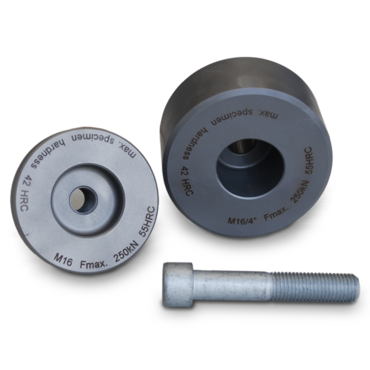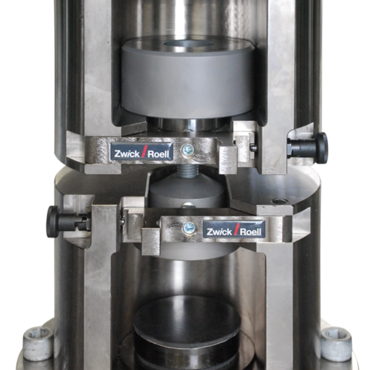ISO 898-1, ISO 3506-1, ASTM F606: testing of threaded fasteners
The ISO 898-1, ISO 3506-1 and ASTM F606 standards describe tests on threaded fasteners (bolts, screws and studs) including steel screws and their mechanical and physical properties such as tensile strength, offset yield (minimum stress), elongation after fracture and hardness.
- ISO 898-1 establishes the mechanical properties of fasteners made of carbon steel and alloy steel (bolts, screws and studs with specified property classes – coarse thread and fine pitch thread)
- ISO 3506-1 establishes the mechanical properties of fasteners made of corrosion-resistant stainless steel (bolts, screws and studs with specified grades and property classes)
- ASTM F606: Standard Test Methods for Determining the Mechanical Properties of Externally and Internally Threaded Fasteners, Washers, Direct Tension Indicators, and Rivets
As some of the most important fasteners, bolts, screws and studs are not only considered universally important in industry settings, but also for every day purposes. They are used in the construction of complex machinery and equipment, as well as vehicles and buildings. Since mechanical stress is concentrated on these types of connection points, the integrity of fasteners is extremely important. Therefore bolts, screws and nuts are subject to strict safety requirements.
Test method overview Property classes Tensile test Proof load test Head soundness test Hardness test Torsion test Notched impact bending test Testing systems
Testing of threaded fasteners to ISO 898-1
The following table provides an overview of the mechanical test method specified in standard ISO 898-1.
In the different mechanical test methods a distinction is made between finished and full-size fasteners and between fasteners with full loading capacity and reduced loading capacity.
Finished fasteners are fasteners for which all manufacturing steps have been completed. So they are completely finished fasteners.
Full-size fasteners are finished fasteners on which the shank diameter is fully retained for tensile testing. They are also referred to as full shank fasteners. This designation excludes thin and expansion bolts and banjo bolts.
Fasteners with reduced loading capacity are usually not fully loadable due to their head geometry (so called weak-head screws), unlike screws of typical geometry of the same property class. Such screws are identified with a leading zero.
| Excerpt of the ISO 898-1 standard | Test methods | Mechanical properties to be determined | Fastener or specimen type |
|---|---|---|---|
| 9.1 | Tensile test under wedge loading | Tensile Strength | Finished bolts and screws (excluding studs) |
| 9.2 | Tensile test | Tensile Strength | Finished bolts, screws and studs |
| 9.3 | Offset yield (minimum stress), percentage elongation after fracture | Full-size bolts, screws and studs | |
| 9.4 | Tensile Strength | Bolts and screws with reduced loadability | |
| 9.5 | Fasteners with waisted shank | ||
| 9.6 | Proof Load Test | Stress under proof load, permanent elongation | Finished bolts, screws and studs |
| 9.7 | Tensile test | Tensile strength, yield strength/offset yield, strain at break, reduction of area | Machined test pieces |
| 9.8 | Head soundness test | Head strength | Bolts and screws |
| 9.9 | Hardness testing | Hardness to Vickers, Brinell or Rockwell | All bolts and screws, in particular those which are too small for a tensile test |
| 9.10 | Decarburization test | Surface hardness (HV 0.3) | Property classes 8.8 to 12.9 |
| 9.11 | Carburization test | ||
| 9.12 | Retempering test | ||
| 9.13 | Torsion test | Breaking torque | All screws except waisted shank screws |
| 9.14 | Charpy impact tests | Toughness under impact load | Machined test pieces made from bolts, screws and studs with a diameter ≥ 16 mm |
Property classes
Property classes of bolts and screws are identified with two numbers separated by a dot. The number to the left of the dot is the tensile strength in MPa divided by 100. The number to the right of the dot indicates the tenfold of the yield point or offset yield ratio.
For example, a screw of property class 9.8 would have the following nominal values:
- Nominal tensile strength: Rm = 9 × 100 MPa = 900 MPa
- Yield point ratio: Re/Rm = 8 ÷ 10 = 0.8
- Yield point: Re = 0.8 × 900 MPa = 720 MPa
The property class of a nut is identified with a single number, which corresponds to the highest property class of a screw with which the nut can be paired. A nut of property class 9 can be paired, for example, with a screw up to property class 9.8.
Overview of property classes
| Material characteristic value | 3.6 | 4.6 | 4.8 | 5.6 | 5.8 | 6.8 | 8.8 | 9.8 | 10.9 | 12.9 |
Yield strength Re | 180 | 240 | 320 | 300 | 400 | 480 | 640 | 720 | 900 | 1080 |
| Tensile strength Rm (N/mm²) | 330 | 400 | 420 | 500 | 520 | 600 | 830 | 900 | 1040 | 1220 |
Tensile test on threaded fasteners to ISO 898-1, ISO 3506-1, ASTM F606
Threaded fasteners are selected very carefully with regard to their industrial application and are integrated carefully into the design. Accurate determination (via tensile tests) of the elastic tensile modulus and the limits of elastic loading is essential, since these values determine the limit forces required for a secure, reliable threaded connection.
All variations of the tensile test (Sections 9.1-5 and 9.7) must be performed according to ISO 6892-1. Specifics for tensile tests on threaded fasteners are covered in standards ISO 898-1, ISO 3506-1 or ASTM F606. For example, the test speed shall not exceed 25 mm/min. In addition, a maximum test speed of 10 mm/min applies when determining the yield strength or offset yield.
For full-size fasteners, the tests defined in sections 9.2 and 9.3 for the determination of offset yield, tensile strength and percentage elongation after fracture may be combined in one tensile test.
Testing equipment for tensile tests on fasteners to ISO 898-1, ISO 3506-1
Deciding factors for the dimensioning of a testing machine are the size and strength of the fasteners to be tested. For fasteners with a thread starting at M8, we recommend a materials testing machine for large test forces (as of Fmax 600 kN). Starting at an M12 thread a maximum force of 1200 kN is required, and as of M18 a testing machine with a maximum force of 2,500 kN.
The use of hardened specimen grips allows for efficient testing of finished fasteners, as well as turned screws and bolts and set screws. The specimen with corresponding specimen holder is inserted into the specimen grips, which are freely accessible from the front, and automatically centered in the tensile axis. For the tensile test under wedge loading, angled head mounts are available in angle increments of 4°, 6° and 10°.
An extensometer is required to determine the offset yield For tensile tests on machined test pieces, any type of commonly used extensometer can be applied—from a contact version such as the makroXtens to the optical videoXtens.
To grip the specimen in the testing machine, specimen grips for screw tests with corresponding head mountings and threaded mountings are used, which ensures compliance with the minimum specimen length specified in the standard.
Proof load test on threaded fasteners to ISO 898-1
The proof load test (section 9.6) is a tensile test that is only performed up to a pure intended test load. The exact test load depends on the thread, diameter of the fastener and the property class. These are listed in a table in ISO 898-1.
When applying the test load, the test speed shall not exceed 3 mm/min. The load is held for 15 seconds and the fastener has passed the test if there is no resulting plastic elongation within the permissible measurement uncertainty of ±12.5 μm.
Head soundness test on threaded fasteners
For the head soundness test, the bolt or screw is inserted into a pre-drilled solid block at an angle. The head of the fastener is bent at a defined angle with a striking motion, and no signs of cracking shall be visible after the test. This test is generally used when the tensile test under wedge loading cannot be carried out because the fastener is too short.
The Charpy impact test is only used in testing of fasteners, if it is required by a product standard or a corresponding agreement is made between the manufacturer and the customer.
Hardness test on threaded fasteners
The methods to Vickers (ISO 6507-1), Brinell (ISO 6506-1) or Rockwell (ISO 6508-1) are permissible for the determination of hardness.
For hardness testing to Vickers a minimum load force of HV 10 applies. Hardness testing to Brinell is mainly performed with HBW 1/30 or HBW 2.5/187.5. For hardness testing to Rockwell, scale B (HRB) is used for fasteners of property class 4.6 - 6.8 and scale C (HRC) for property classes 8.8 - 12.9. In the event of arbitration, the Vickers hardness test shall be used as reference.
Hardness is either measured on the cross-section or on the surface. In the first case, a cross-section specimen is taken from the threaded area. Indentations are made near the fastener’s axis and the resulting hardness is also referred to as core hardness. When hardness is measured on the surface, the surface must be flat (e.g. on the head, on the end of the fastener or on the unthreaded shank) after removal of any coating.
In the retempering test Vickers hardness is measured before and after heat treatment. The reduction of hardness after retempering, if any, shall be less than 20 Vickers units.
In the decarburization and carburization test hardness is tested to Vickers with a test force of 2.942 N (HV 0.3) on a longitudinal section through the thread axis. The thread zone is measured on three defined points with different distances to the surface. Differences in measured values that are either too small or too large are an indication of decarburization or carburization.
Charpy impact test on fasteners
The purpose of the Charpy impact test is to determine the loading capacity of the fastener material at low temperature. Since a Charpy V-notch specimen has to be cut from the fastener, the nominal diameter must be at least 16 mm. The standard ISO 148-1 Charpy pendulum impact test describes this test method.

